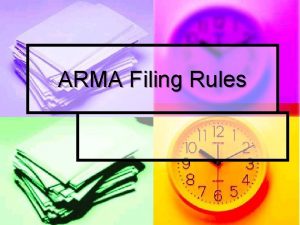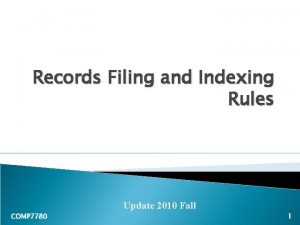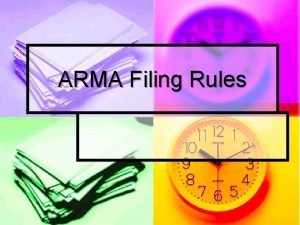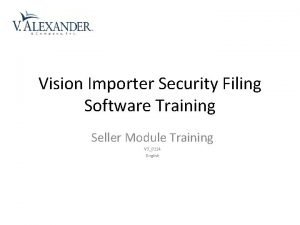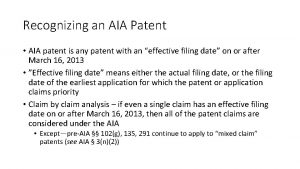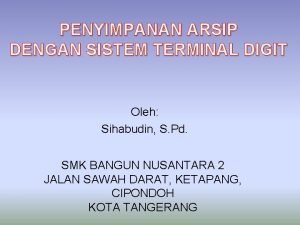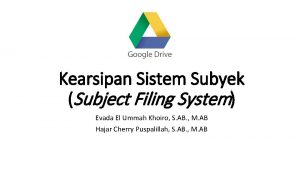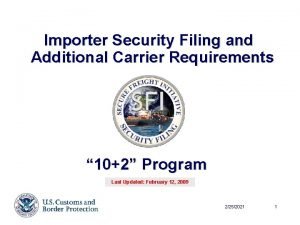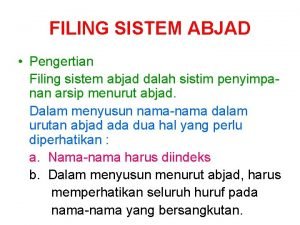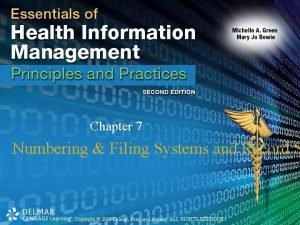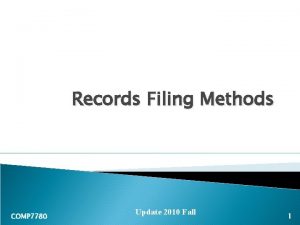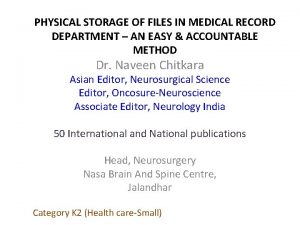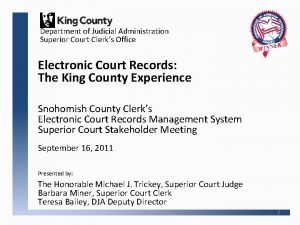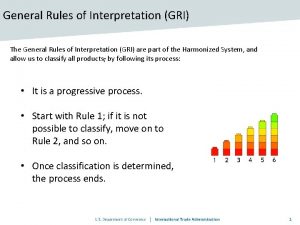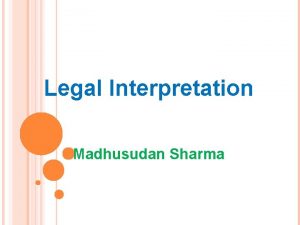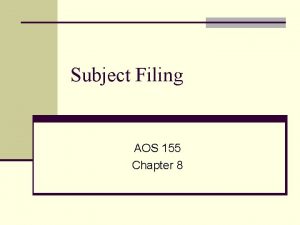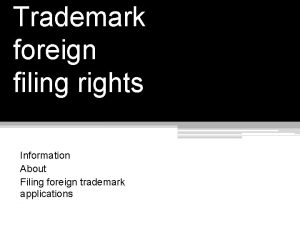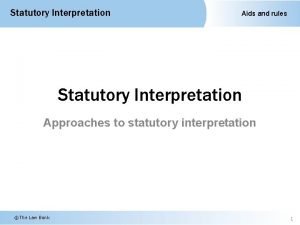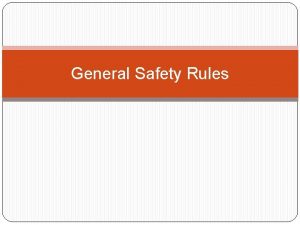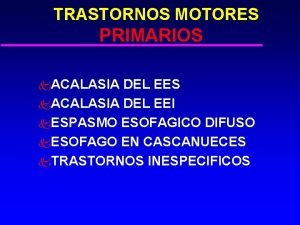The General Rules of Interpretation Filing EEI Essential


























- Slides: 26

The General Rules of Interpretation

Filing EEI • Essential documents for legal exportation. • Authorization to file the EEI. • Information to file the EEI. • Filing the EEI: • Determine and file the correct schedule B or HTS number. 2

Authorization to file the EEI ii) When the USPPI authorizes an agent to file the EEI on its behalf, the USPPI is responsible for: (A) Providing the authorized agent with accurate and timely export information necessary to file the EEI. (B) Providing the authorized agent with a power of attorney or written authorization to file the EEI (C) Retaining documentation to support the information provided to the authorized agent for filing the EEI, as specified in § 30. 10. 3

15 CFR 30. 3 (f) Authorizing an agent. In cases where an authorized agent is filing EEI to the AES, the agent shall obtain a power of attorney or written authorization from a principal party in interest to file the information on its behalf. A power of attorney or written authorization should specify the responsibilities of the parties with particularity and should state that the agent has authority to act on behalf of a principal party in interest as its true and lawful agent for purposes of creating and filing EEI in accordance with the laws and regulations of the United States. In routed export transactions the USPPI is not required to provide an agent of the FPPI with a power of attorney or written authorization.

Shipper’s Letter of Instructions Most Frequently Overlooked Fields 5

Information to file the EEI 15 C. F. R. § 30. 3(e)(1) (i) Name and address of the USPPI. (ii) USPPI's EIN or DUNS (iii) State of origin (State). (iv) FTZ if applicable. (v) Commercial description of commodities. (vi) Origin of goods indicator: Domestic (D) or Foreign (F). (vii) Schedule B or HTSUSA, Classification Commodity Code. (viii) Quantities/units of measure. (ix) Value. (x) Export Control Classification Number (ECCN) or sufficient techinal information to determine the ECCN. (xi) All licensing information necessary to file the EEI for commodities where the Department of State, the Department of Commerce, or other U. S. government agency issues a license for the commodities being exported, or the merchandise is being exported under a license exemption or license exception. (xii) Any information that it knows will affect the determination of license authorization (see Subpart B of this part for additional information on licensing requirements). 6

Reporting the Schedule B Number • Why is accuracy important? • Avoid Government fines and penalties. • Government’s use of Export Data. • Determining the schedule B or HTS number. • Both HTS and schedule b numbers can be used on the EEI. • General Rules of Interpretation (GRI). 7

GRI Rule # 1 • Merchandise must first be classified in the HS by the 4 -digit heading which most specifically describes the merchandise. 8

Applying Rule # 1 • Let’s say your shipping toothbrushes. • Step 1: Browse chapters and look for the most closely related to your item. • http: //www. census. gov/foreign-trade/schedules/b/2010/#chapters 9

Applying Rule # 1 (cont. ) • Once you have the chapter, click on the link to look for the 4 -digit heading within that chapter that describes your item more precisely. 10

Applying Rule # 1 (cont. ) • Once you have determined the 4 -digit heading, search for the 10 -digit schedule b within that heading. The correct schedule b number for toothbrushes is 9603210000. 11

GRI Rule # 2 (a) • Incomplete or unfinished articles & unassembled or disassembled articles. • Are classified as complete articles. • Must have essential character of finished article. 12

GRI Rule # 2 (a) • Example: Unassembled oil platform. • If the platform is complete but unassembled, apply the same schedule B as for the complete platform. In this case, the schedule B is 8430494000. 13

GRI Rule # 2 (b) • Mixtures and combinations • As long as the specific mixture is not referenced elsewhere, classify according to essential character. • Example: Stainless Steel table fork with plastic coated handle. 14

GRI Rule # 2 (b) • Example: Stainless Steel table fork • Stainless • Plastic Coated Steel Handle • Classify according to essential character: not plastic nor steel but kitchen article of steel, heading 7323 15

GRI Rule # 3 • If goods can be classified in two or more areas: • A) Choose more specific heading. • B) Mixtures are classified based upon components that gives them essential character. • C) If product cannot be determined by the above, classify in last numerical order of choices. 16

GRI Rule # 4 • If unable to classify using GRI# 1 -3: • Classify goods according to which they are most similar. • Should be used infrequently. 17

GRI Rule # 5 (a): Special Situations • Specially fitted containers are classified with the article. • Except when the container determines the essential character. • Example: Camera cases, cases for musical instruments, gun cases, etc. • What about a glass bowl containing candy? 18

GRI Rule # 5 (a): Special Situations • Example: Glass bowl containing candy • Candy • Glass Bowl • A glass bowl containing candy is classified separately; the candy on one hand the bowl on the other, unless that bowl is specially made to fit that candy. 19

GRI Rule # 5 (b): Special Situations • Packing material and packing containers are classified with the goods. • Must not be suitable for repetitive use. Example: Cardboard boxes. 20

GRI Rule # 5 (b): Special Situations • Example: Cardboard boxes. • Packing material and packing containers (normally used for packing) are classified with the goods. 21

GRI Rule # 6 • Classification of goods in the subheading of a heading shall be determined according to: • The terms of subheading. • Related subheading notes. Section, chapter and subchapter notes may also apply. 22

Chapter Notes

Chapter Notes

Filing an EEI: Flowchart Request for pick up Authorization? Yes No Authorization is obtained Information? 15 CFR 30. 3(e)(1) Obtain Authorization Yes No POA USPPI or FPPI Transmit EEI Obtain Information Written Authorization Info is obtained Any written form 25 Signed SLI

Thanks for your Attention 26
 General rules of interpretation
General rules of interpretation Pir sir eei
Pir sir eei Manometria
Manometria Eei codes
Eei codes Arma indexing rules
Arma indexing rules Cross referencing example
Cross referencing example Arma filing rules
Arma filing rules How does interpretation b differ from interpretation a
How does interpretation b differ from interpretation a Plamatic acid
Plamatic acid International rules for the interpretation of trade terms
International rules for the interpretation of trade terms International rules for the interpretation of trade terms
International rules for the interpretation of trade terms Importer security filing form template
Importer security filing form template Patent effective filing date
Patent effective filing date Taxa biology
Taxa biology Dua angka dari belakang sebagai unit 1 menunjukan
Dua angka dari belakang sebagai unit 1 menunjukan Paper based filing system
Paper based filing system Subjective filing sistem adalah
Subjective filing sistem adalah Ams filing requirements
Ams filing requirements Filing sistem abjad adalah
Filing sistem abjad adalah Patent effective filing date
Patent effective filing date What is terminal digit filing
What is terminal digit filing Patent effective filing date
Patent effective filing date Sofista filing
Sofista filing Geographic filing system example
Geographic filing system example What is terminal digit filing
What is terminal digit filing Indeks nama perusahaan
Indeks nama perusahaan King county superior court ecr
King county superior court ecr




